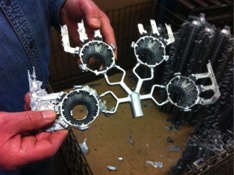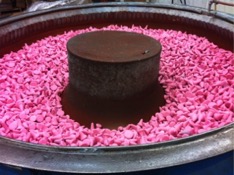What the Heck is Die Casting?
 My name is Eve Mayer and I don’t work in die casting. I am an author who works in social media, the world of words where everything we create can neither be touched nor felt with the human hand.
My name is Eve Mayer and I don’t work in die casting. I am an author who works in social media, the world of words where everything we create can neither be touched nor felt with the human hand.
So, when I was invited (or rather, I invited myself) to tour the die casting factory of one of my company’s favorite clients, Pace Industries, I think they thought it was pretty odd.
The fact is I love factories because of my parents. For some strange reason, since I was little, they have brought me to see how all types of things are made; and because we are good eaters, it was usually food factories like Ben and Jerry’s or candy or potato chips. These experiences have allowed me to develop an appreciation and curiosity for manufacturing.
Although Pace had described in detail what they do, I just didn’t completely get it until I saw it with my own eyes. After all, die casting to the outside world sounds very ominous and foreign. So, the purpose of my tour was to understand – What the heck is die casting?
Die Casting is using a mold to make stuff out of metal. I’m probably not saying these terms by industry standards, but for those of us in the everyday world, I think that is what I learned that die casting is.
 Die casting isn’t a glamorous industry. It is a detailed, precision necessary industry where hard working people use machines to carefully craft metal pieces like auto parts, light bulb bases, motorcycle pieces, back sides of carpeting and bed springs. My view is probably skewed as I toured an aluminum factory and die casting is done with several different types of metals like zinc, magnesium and aluminum.
Die casting isn’t a glamorous industry. It is a detailed, precision necessary industry where hard working people use machines to carefully craft metal pieces like auto parts, light bulb bases, motorcycle pieces, back sides of carpeting and bed springs. My view is probably skewed as I toured an aluminum factory and die casting is done with several different types of metals like zinc, magnesium and aluminum.
For those of us in the world of creating intangibles, it is pretty cool to see things created that you can touch and feel. The process not only sounds interesting but also uses more necessary creativity than I would have expected.
Let’s say you need a piece of metal for a specific job. First, you must design it in such a way that it can accomplish this job. Next, you need to decide whether it should be forged or die cast. Die cast means that a mold will be created typically out of precision steel and split into two halves. These halves will be put together and held there by hydraulics while hot metal is injected into the mold and cools for up to one minute before the new metal piece is released.
After the piece comes out of the mold, it needs to be trimmed and polished. I thought the polish process was interesting because it basically looked like they put metal pieces into a big bowl of pink rocks and shook the metal piece around until the rough edges cam off.
 Some metal pieces need to be pretty and some don’t. For example, if you are having a piece built for the inside of a car engine that someone will never see once built, you don’t want to spend money on making this piece pretty, it just needs to be functional. Another metal piece might be on a motorcycle but sit on the outside of the bike in full view so it needs to be functional but also have a nice look to it. This is where specific processes that deal with painting or chroming parts comes into play.
Some metal pieces need to be pretty and some don’t. For example, if you are having a piece built for the inside of a car engine that someone will never see once built, you don’t want to spend money on making this piece pretty, it just needs to be functional. Another metal piece might be on a motorcycle but sit on the outside of the bike in full view so it needs to be functional but also have a nice look to it. This is where specific processes that deal with painting or chroming parts comes into play.
As you might imagine, the mix of machines and people with high volume makes safety very important in die casting. Pace has an interesting view that has helped them dramatically increase their rates of on-the-job safety. A Pace executive believed that safety is a mindset that is constant – meaning that safety at home and on the job cannot be separated. He asked employees to make a personal safety pledge. Employees wrote down and posted safety commitments that were important to them in their own lives and posted them near the workspace. For example, “I will not text or make phone calls when I drive.” It was pretty inspiring to see these pledges for safety hanging on the wall and to hear about the positive effects this movement has had.
All in all, I really enjoyed my tour of a die casting facility. It was rewarding to see the entire process of how so many parts I take for granted are being made right here in the USA. And for us regular Joes, the answer to “What the heck is die casting?” is – it is the process of making metal pieces out of a mold. See, it’s not that scary after all.

I found it interesting that you mentioned that with die casting, you can make other things out of metal. I had never heard about this term until I went to one of my lectures this semester and my professor mentioned it and said that it can be used for auto part replacement and others. In my opinion, doing diecast might actually be easier than getting a replacement part, so if anyone is in need of this service, they should talk to a local service to help them.